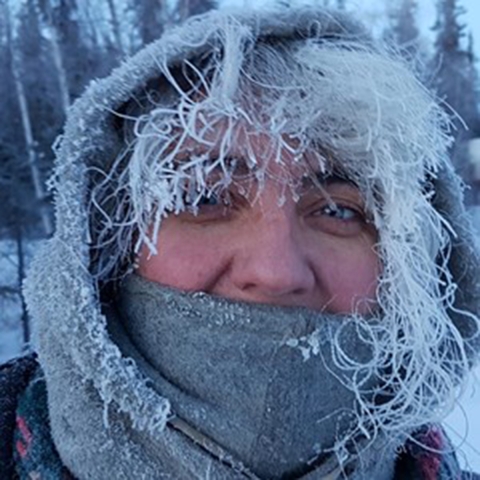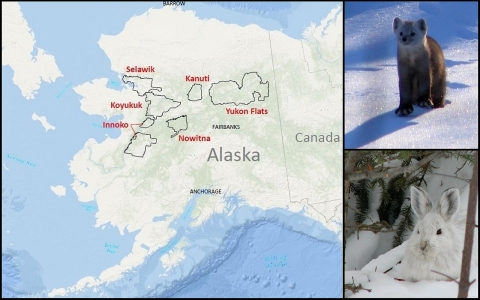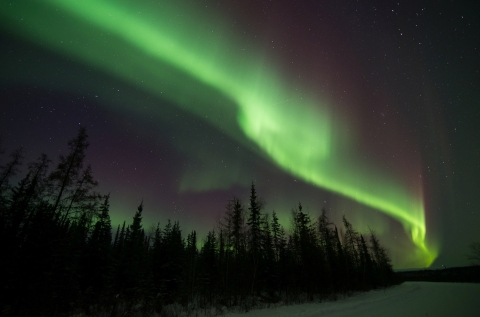In Alaska, the U.S. Fish & Wildlife Service employs a small army of dedicated and passionate staff with a large spectrum of roots. Some were born and raised in Alaska. Others have come from around the world. Regardless, some stay to do a job they feel is important enough to spend a lifetime doing. Karin Bodony works in some of the country's most remote National Wildlife Refuges.
What do you do for the U.S. Fish and Wildlife Service?
I work for the U.S. Fish and Wildlife Service at Koyukuk, Nowitna, and Innoko National Wildlife Refuges. I work as a biologist and environmental outreach coordinator and educator at the Refuge Complex. In some ways I'm more of an ecologist, because I do like to see the bigger picture of how all the pieces fit together, both the biotic and abiotic, and then changes over time. That's definitely one of the advantages of being someone in this role who stays in the same place for a long time. You see a lot of the changes over time. You get to know people in the communities who've been here their whole lives — the local elders who have seen 60 to 80 years of change. They remember things that their grandparents said. I think when you're situated in one place for a long time, you really kind of get connected and get to know a place in a different way than you do when you're just visiting or spending a few years here and there.
Where are the refuges you work in?
So, we are in the bush. We're flying, although you can get here by dog team. We're on the Yukon River, about 350 miles west of Fairbanks. We're about halfway between Fairbanks and Nome on the same latitude. Located right on the north bank of the Yukon River. It's about 550 to 600 residents. We have a boarding school for high school students that draws maybe 150 students, plus staff, which kind of bumps up our total population during the school year.
Where did you grow up?
I grew up in Colorado, in the mountains, and I spent most of my childhood outdoors whenever I could be. And I just kind of always thought that's how everybody grew up. I tried really hard to get my dog growing up to want to be a sled dog. He was a mutt. And he did pull a sled; he didn't really pull me. But I did make him pull a sled like when I'd spend the night at a friend's house, I'd load up all my gear and pack it in the sled and make him pull it.
How did you get involved with dog sleds and skijoring?
So when I grew up in Colorado in the '80s, there was a lot of snow. We did a lot of snow sports, and a ton of cross-country skiing. I think if he had more inclination to actually pull and be a sled dog, like if his vision had been mine, then I definitely would have started skijoring at a very young age, I started skiing when I could walk basically. So it was kind of a no-brainer when I moved to Alaska to get some sled dogs and do a lot of skijoring and dog sledding. That's probably one of my main passions in life. It kind of combines my love of the outdoors and animals and just physical activity, which is also what I think drew me to become a biologist. I don't care to sit in front of a computer much more than I absolutely have to.
How did you end up in Alaska?
I moved to Alaska in 1994. I went to graduate school in Fairbanks. I worked on my master's degree here at the refuges and then took a permanent job as I completed my master's program. I started out studying yellow-cheeked voles in post-fire/early years after burns, looking at changes in population and population dynamics in those burned areas. So that kind of got me started in studying small mammals, and fire ecology and plant ecology. That kind of led me toward doing more of the work at our refuge related to plant ecology, successional changes, climate change climate change
Climate change includes both global warming driven by human-induced emissions of greenhouse gases and the resulting large-scale shifts in weather patterns. Though there have been previous periods of climatic change, since the mid-20th century humans have had an unprecedented impact on Earth's climate system and caused change on a global scale.
Learn more about climate change , weather conditions, some of the abiotic conditions, snowfall, and permafrost and things like that.
What got you interested in studying small mammals?
My mom is a botanist. She always claims that she studied plants because they sit still and you don't have to go find them. They're like a captive audience. But I just had that interest in small mammals. I felt like it was something that was pretty accessible and hands on literally, like live trapping. And in that kind of interaction, you can ask some really interesting questions without a ton of effort. Because, you know, these creatures are fairly numerous. They have small home ranges. And you can really ask some interesting questions about habitat associations and population dynamics and things like that.
Do you have a favorite mammal you study?
In my master's work, I was live trapping yellow-cheeked voles, and they were so great. They're just such cool little critters. We were spending entire summers interacting with them. That was pretty amazing. We're more used to probably red-back voles that are kind of mouse-sized. Yellow-cheek voles, they're twice the size of a mouse. They're really cute. They're super cute. And they're social. They live in colonies. They spend winters together in these mixed family meeting groups underground. They're spending the fall collecting food to store, and then they spend the winter together kind of huddled up to keep each other warm. Other voles tend to be wilder, in a way and that they're just really flighty, and they fight and run away. But yellow-cheeked voles, because they're so social, I think they interact a lot by touch. I'm using my hands here a lot, because I have to because they're so tactile. Just the whole experience, working with these voles was very tactile. They respond a lot to touch and they were very friendly in ways you wouldn't expect. I don't know if it's because they're social. They communicate verbally, like vocally, they vocalize in their communications, and they whistle. So, as we were spending a lot of time out there working with them, we kind of got to crack the code a little bit of their language and hear certain sounds that they would make when they were alerted. Because, as we're walking through, they'd give these alarm signals and things. But also, when it was raining, when it would stop raining, you would hear them whistle to each other to say, hey, the rain stopped, you can come out now. It's pretty neat.
Then we had these little cotton nestlets. They're little pressed cotton pads that were inside the live trap to give the voles someplace to stay warm. And they kind of tear them up and create a nest of them so that they could stay warm when it was cold out or damp. And they would steal them out of the traps. And sometimes put them in the front of their little burrow entrance and eat. Like they'd bring fireweed or like equisetum horsetails, or berries. And they would sit at the entrance of their little burrow and sit on their little cotton nestlet and eat berries.
How do you like rural Alaska?
Coming to rural Alaska was like coming home because culturally, my world view, my identity, my spirituality, all these things that I had grown up with meshed very well with the culture that I found here, especially the native culture. My family comes from the Upper Midwest, from Minnesota, Wisconsin. My mom's family is in rural Wisconsin, and part of our family is indigenous to that area of northern Wisconsin, Potawatomi Ojibwa, that cultural group. Often when you grow up a way, you don't think about your life being any different than anybody else's life. Then you go to college, and you meet all these people, and you find out that, wow, life's really bigger and more complex than you ever thought.
Being out in the environment, for months and months at a time, like three or four months at a time each summer. Interacting with the wildlife, with the plants, with the elements. There were mental aspects and spiritual aspects to that experience. All the players that I interacted with during the day became the characters in my dreams and the storylines that started to filter through my mind. I found after or during that experience, when I was talking with elders, when I was reading the stories, things made sense. I understood why these creatures were the characters in these traditional stories. So I feel like it kind of came in through a back door. Like it didn't come into completely through human interaction, but through a shared interaction with the environment that then gave us common ground to build relationships and to have conversations.
How does your spiritual experiences work with your scientific work?
This isn't something that I learned when I came to Alaska. This is something that I grew up with, with this sort of dual way of thinking, and you learn to compartmentalize how you think about things. So you become very skilled at doing your science thing, and everything falls into the science bin, because it's the scientific method and it follows these rules. And yet within that, all those experiences enrich my personal life, my spiritual experience, but that doesn't always feed back into my scientific work. It's there, it's driving me, it's supporting me in what I do in science. But it may not be mentioned in a field report. But at the same time, it may affect what I say and do and how I prioritize things. It may give me the drive to write comments in a proposed land use plan that I wouldn't be quite so passionate about if I didn't feel that land connection.
I think society is opening the door for that in so many ways, so many levels. We all do this, right? We all have this inner self and then we have this self that we present to the world. And creating a society that's more willing to accept presenting all of yourself to the world, without judgment, is a beautiful vision that I hope we're working toward.
What do you like about your position?
I'm also a professional communicator. And I think it's really important when we do science, to make sure that other people are aware of what we've learned. I love having the opportunity to take pretty fascinating science and then translate that into something that conveys how awesome it is to the folks out there, you know. And vice versa. It's important to hear the perspective of those living around us because they see and observe and know things in many fascinating ways. Not always ways that mesh well with what we're seeing scientifically. We're seeing that a lot in in our society right now. Sometimes I think the conversation about Indigenous Knowledge and science can swing too far in the direction of like, all Indigenous Knowledge is right and true and good. Sometimes our myths are not true. Sometimes our myths are harmful. So, I don't think we can throw science out in our passion for accepting other ways of knowing.
What kind of work do you do with communities and the people around you?
I've had some really neat opportunities to work with the native community. One example was we worked with a student who was, I think she was working on her PhD. We also worked with a climatologist, and we were talking to elders about the kind of changes that they'd seen in weather patterns, and just basically in their surroundings over their lifetimes.
A lot of times we hear about how cold the winters were, stories like, "Moose didn't used to be here," or, "We weren't able to rely on moose meat." Now that's like our main staple, now. Permafrost changes, people talking about traveling between lakes, and when I used to go from this lake to the next slide, you'd go way over this hill. Well, now that hill isn't there anymore and you can see from one leg to the other because there's just this little bump. Well, that definitely indicates that there was a lot more permafrost underneath this landscape between the lakes, the portages were higher, that permafrost has melted, that land has settled. And then we took those pieces and looked at weather records and see when were there extremely cold winters. How does that shake out with what people are remembering? So that was one project that I worked on. Another was documenting place names on the Koyukuk River, and we worked with elders and youth when we just took a boatload of folks and we drove up the river, and we stopped with all these places where things that happened, people had winter camps, old cabin sites, old homesteads, you knw and letting the students interview the elders and record their stories. It was just phenomenal. Really cool. Really fun too, as we traveled and hearing the elders say, "Oh, this use did go this way, there used to be these cabins at the base of the hill, and this cut through as washed out," and things. So those kinds of projects are really fun and really valuable.
What has Alaska taught you about itself?
What has Alaska taught me about itself? Patience. There's a place on the Koyukuk Refuge. It's the Nogahabara Sand Dunes. I've done a lot of work out there. It's an area of active sand dunes about six miles across. It was created by sand that blew in after the end of the last Ice Age. This area was unglaciated but there were glaciers nearby. It's this ancient landscape. When I'm out there, it's one of the quietest places I've ever been. And I sit and listen to the silence, and I hang out with the trees, and I think about how the trees are there all of the time. All year long. Through the dark winters. Through the wind and cold and snow. Through the long, full on daylight summers, with the rain dripping off of their needles, They just sit and endure. And these trees, some of them are like 350, 400 years old. They've sat there with that same view, nurtured by the rotting soil created by their grandparents, that lived for hundreds of years and died and rotted and are nurturing them. And they endure. And they endure all the storms and all the all of it and they just thrive, right? So, what can we take away from that is patience. Just wait, just stay, it's going to change, the seasons change, you know. Now we're in the middle of this kind of thing with this pandemic. It feels like it's never gonna change, but these trees have been out there for 350 years and they're still doing it, right? We can do it. Hang in there. Be resilient and do what you can to thrive in in the place where you're planted.
Adapted from episode 32 of the My Life, Wildlife Podcast!
In Alaska, the employees of the US Fish and Wildlife Service are shared stewards of world-renowned natural resources, and our nation's last true wild places. The lands and waters of this place we call home, nourish a vast and unique array of fish, wildlife, and people. Our hope is that each generation has the opportunity to live with live from discover, and enjoy the wildness of this odd inspiring land and the people who love and depend on it.
Follow us: Facebook Twitter Medium
Subscribe to My Life, Wildlife! On Apple or wherever you get your podcasts










